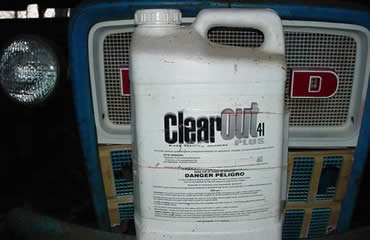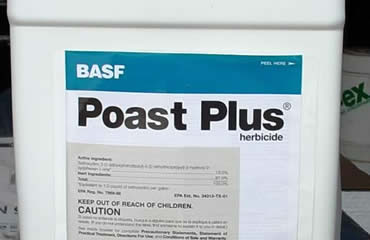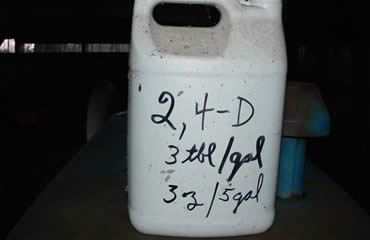Well, you thought you did everything right. Let's see, got that soil test, applied recommended lime and fertilizer, plowed vigorously and prepared a smooth seedbed, inoculated the legumes, carefully broadcast your seed, covered lightly and prayed for rain. Okay, then why are you standing here now and looking at an ugly patch of weeds choking out your deer plot? This is what they neglect to tell you about at the seed and feed dealers. Maybe even the county agricultural agent or the wildlife biologist didn't tell you either because the infestation does not really occur at planting, but several weeks or more down the road.
Weed control is a very complex subject with a complex answer that varies from one piece of ground to another, depending upon the seed species or root systems already in the soil, the last time it was plowed and the weather (especially rainfall). There are hundreds of species of weeds, both annual and perennial, ready and willing to jump on your planting and take advantage of all that money you spent on lime and fertilizer!
Why even bother controlling weeds? Because they can severely compete with your deer planting and thus lower the production, quality and utilization of your plot. A certain level of weed infestation can be tolerated, depending on what the invader is and what the final product of the target planting is - forage or seed production.
In late winter through mid-spring, you could be dealing with both categories of food plots - a cool season planting, planted last fall in perennial clover, alfalfa, or trefoil which is now being invaded by warm season grasses or a warm season planting, planted in April or May with corn, grain sorghum, cowpeas, jointvetch, alyce clover, soybeans, etc. Each has its own set of problems and remedies we'll discuss later.
Let's go through this step by step procedure to simplify a complex problem and lead us to the best approach to win the weed wars.
Identify the Enemy: Is it a broadleaf or a grass? Is it an annual or a perennial? Was it here last year? If you can't identify the weed, bring a sample to your Agriculture Extension Agent, University agronomy department, wildlife biologist, or even a nearby farmer. Here is a short list of some of the most common worst offenders by category. Broadleaf weeds include pigweed, ragweed, horsenettle, thistle, jimsonweed, morning glory, milkweed, coffeeweed (sicklepod). Grasses include fescue, bermudagrass, bahia grass, johnsongrass, crabgrass, foxtail, panicum and many others.
Planning Is Important: In some respects, if you are standing in the weeds in June wondering what to do, it's too late for some of the best tactics. What weeds invaded this plot last year? Chances are it's the same species that you are looking at now. Your planning efforts from last year should have heavily influenced what crop is in the field now for the deer - a broadleaf or a grass. In other words, if you have had weed problems in the past from the grass family, such as crabgrass, plant a broadleaf (forb) such as clover, jointvetch, trefoil or peas. Vice versa, plant a grass such as grain sorghum (milo) if your weed problem has been a broadleaf. This system allows for selective control with chemical herbicides. In other words, you can get rid of your unwanted weeds by spraying right over the top without killing your target planting. See what I mean by planning?
Control Method (choose your weapon): The three C's: Cut, Competition or Chemicals. Many deer food plants are highly tolerant to repeated mowing or cutting. These include well established cool season crops like clover, alfalfa, and trefoil. You can often give your plants a good competitive edge by mowing the plot, which weakens or kills the weeds (slows down their regrowth) and stimulates quick regrowth of your target plant. This won't work, however, with peas, beans, or grain sorghum because they are warm season plants that do not respond well to cutting.
By planning ahead, you can also out-compete your weeds using shade. For example, if your weed problem last year was crabgrass, bermuda or fescue, you can plow in early spring, let sit, plow again and plant in grain sorghum (10 pounds/acre) or corn (15 pounds/acre), which grow tall and shade out these grasses. Broadcast rate is very important here (5 pounds/acre grain sorghum and 10 pounds/acre corn mixed or 10 pounds/acre grain sorghum by itself). You can even mix in iron and clay cowpeas (25 pounds/acre for a three-tiered level of shade. Variety can also be very important. For grain sorghum, use tall growing bird resistant varieties (not WGF, a knee high plant) for best results. For effective control, you may have to do this shade plot two years in a row to really knock back your grassy weeds.
Of all the options, however, chemicals are often the best choice for your food plot. Chemicals are safe, effective, inexpensive, and cut manpower and plowing tremendously. From this point on, we'll concentrate on chemicals.
Getting Started With Chemicals: Obviously, you have to have some spraying equipment. Usually a garden two or three gallon sprayer won't do it if your weed problem is fairly extensive or your plot is big. You will quickly find yourself "under-gunned." One possible exception is spraying thistle plants or fescue clumps individually if you have 25 or 50 of these isolated plants per acre in clover or other cool-season plots. A two-percent solution of Glyphosate or 2,4-D can be used for this.
More likely, if you are serious about food plots, you will need a spray rig for a 4-wheeler or tractor. These are available in electric or gas driven for 4-wheelers and electric or PTO driven for farm tractors. Boom type sprayers are usually better than rainbow type sprayers because they minimize spray drift over non-target plants as well as the operator. Sprayers range in price from $100 to $2,000 depending on the size and features. If you have big fields with good access, you may be able to hire your spraying by truck or tractor from a local farm cooperative, seed dealer, or farmer.
What Chemicals to Use: There are hundreds of herbicides on the market. For purposes of this article, we'll concentrate on three - Roundup (41% glyphosate), Poast (sethoxydim) including Poast Plus and 2,4-D Amine. All of these can be mixed with spreader-sticker (surfactant) and liquid ammonium sulfate (Quest) to effectively speed and thoroughly enhance the kill.
 Glyphosate: Glyphosate (also sold under the brand names Clearout, Honcho, Glypro, Razor, Kills All and others) kills everything. Read the labels for spray rates! Its best uses are as a total kill back prior to use of a grain drill or traditional renovation plowing and seeding. With glyphosate and a no-till grain drill, you can just about get rid of your disk harrows or plows. In April, spray glyphosate, wait two weeks and no-till drill grain sorghum (5 pounds/acre with cowpeas (15 pounds/acre)) or jointvetch (10 pounds/acre) with alyceclover (10 pounds/acre).
Glyphosate: Glyphosate (also sold under the brand names Clearout, Honcho, Glypro, Razor, Kills All and others) kills everything. Read the labels for spray rates! Its best uses are as a total kill back prior to use of a grain drill or traditional renovation plowing and seeding. With glyphosate and a no-till grain drill, you can just about get rid of your disk harrows or plows. In April, spray glyphosate, wait two weeks and no-till drill grain sorghum (5 pounds/acre with cowpeas (15 pounds/acre)) or jointvetch (10 pounds/acre) with alyceclover (10 pounds/acre).
In August, spray, wait two weeks and no till drill a white clover (3 pounds/acre), red clover (4 pounds/acre) and wheat (30 pounds/acre) mix. In either case spring or fall, if no drill is available, spray, wait two weeks, plow and plant realizing that glyphosate will kill all mature plants that it contacts, but the plowing will likely germinate a new crop of weed seeds as it brings the dormant seeds to the surface (probably reduced in number from the previous crop). As mentioned before, glyphosate can also be used as a spot spray for isolated weed clumps like fescue or thistle.
 Poast (Sethoxydim): Poast (Sethoxydim) is a grass selective herbicide that basically kills all grasses but no broadleafs. It must be mixed with crop oil (an oil-based sticker-spreader) for an effective kill and ammonium sulfate will make it even better. Rate is generally 2 pints/acre of all three chemicals. Read the labels for rates as they differ according to weed species!
Poast (Sethoxydim): Poast (Sethoxydim) is a grass selective herbicide that basically kills all grasses but no broadleafs. It must be mixed with crop oil (an oil-based sticker-spreader) for an effective kill and ammonium sulfate will make it even better. Rate is generally 2 pints/acre of all three chemicals. Read the labels for rates as they differ according to weed species!
So, if we are standing in our food plot in May and the plot is a broadleaved perennial like alfalfa, clover, or trefoil being invaded with crabgrass, johnsongrass, Bermuda, foxtail, or fescue, then Poast is our weapon of choice. Even new annual broadleaf plantings of peas, beans, clover, or jointvetch are candidates for Poast which must be mixed with crop oil (spreader-sticker) for best results. This is where last year's planning pays off. If this plot had problems with crabgrass or johnsongrass last year, plow repeatedly and plant a broadleaf. When the noxious grass re-emerges, spray with Poast for the knockout punch.
Whichever scenario, if the noxious grasses are over eight inches tall, mow, wait two weeks and then spray the regrowth. Spray attempts during droughts will be unsuccessful because plants are mostly dormant and will not properly uptake the chemicals. Poast can also be mixed with an insecticide to kill white grubs such as June beetles and Japanese beetles. If the ground of your food plot feels soft and spongy or you have lots of moles or cone-shaped skunk diggings, chances are good that you have white grubs feeding on your plant root system. Contact your county extension agent for recommendations.
 2,4-D: 2,4-D is a broadleaf killer that has been around under many brand names for many years. It will not kill grasses. Grain sorghum infested with coffeeweed, ragweed, jimsonweed, morning glory or any other broadleaf qualifies for 2,4-D application. Grain sorghum is a little sensitive to 2,4-D, so read the label carefully and do not increase the label rate. Atrazine is a great herbicide for grain sorghum or corn, but is a controlled chemical requiring a private pesticide applicator license. 2,4-D, Poast, and glyphosate are all available over the counter with no license required.
2,4-D: 2,4-D is a broadleaf killer that has been around under many brand names for many years. It will not kill grasses. Grain sorghum infested with coffeeweed, ragweed, jimsonweed, morning glory or any other broadleaf qualifies for 2,4-D application. Grain sorghum is a little sensitive to 2,4-D, so read the label carefully and do not increase the label rate. Atrazine is a great herbicide for grain sorghum or corn, but is a controlled chemical requiring a private pesticide applicator license. 2,4-D, Poast, and glyphosate are all available over the counter with no license required.
Read the Label: This cannot be emphasized enough. Do not apply any more chemical than the label directs! Use at least 15 to 25 gallons of water per acre for best coverage and effective kills. Do not mix herbicides unless it specifically states this on the label. Carefully calibrate your spraying equipment (your agriculture extension service can help with this) and carefully measure your food plot acreage. I have seen many half-acre plots that were eyeball estimated to be one acre, thus doubling fertilizer, seed rates, spray rates and everything. It's a good way to waste money and reduce efficiency (not to mention accidentally killing good stuff). Poast always needs to be mixed with crop oil, glyphosate and 2,4-D need to be mixed with spreader-sticker. Read the labels!
Timing is Everything: Weeds are most vulnerable to chemicals when they are vigorously growing or are young tender seedlings. Do not spray when plants are wet or when rain is expected within 24 hours. Do not spray when it is windy, drift will render spraying ineffective and can be harmful to the applicator and surrounding vegetation. Again, when weed growth exceeds six to eight inches, mow, wait two weeks and spray the regrowth. Do not spray during an extended drought, weed control is ineffective and valuable crop species may be injured or killed.
In summary, chemical herbicides are a safe, effective tool to manage deer food plots. Once equipment is made available, effective chemical applications can be made from $15 to $50 per acre. Counting equipment and manpower costs, you cannot plow any cheaper than this and every time you plow, you will germinate a new crop of weed seeds to compete with your deer plants. The best of all worlds would be herbicides followed by no-till drilling. Fewer weeds are germinated, soil erosion is greatly reduced, and seed placement is precise.
Drilled plots can even be treated selectively with herbicide later as needed for final control.
By using chemicals, we have maintained vigorous ladino clover stands from five to eight years without replanting. This is really getting efficient and cost-effective. You too can win the weed wars by careful planning and judicious use of chemicals for weed control. The results will surprise you.
Note: there are hundreds of other herbicides that can be used on deer food plots. The three above were featured because of familiarity, name recognition, low toxicity, easily obtainable and widespread use. Check with your Agriculture Extension Agent for further information.
Herbicide Quick List
Herbicide Target Species Surfactant Needed (spreader-sticker)
Glyphosate* (Roundup and many others) All emerged plants Sometimes (see label)
Poast* (Or Sethoxydim generics) All grasses Crop oil concentrate 2 pints/acre
2,4-D* (Many brand names) All broadleaves Sometimes (see label)
* All kill quicker and better if mixed with ammonium sulfate water conditioner (Quest or Amaze Gold).
— By Kent Kammermeyer / Certified Wildlife Biologist/Consultant